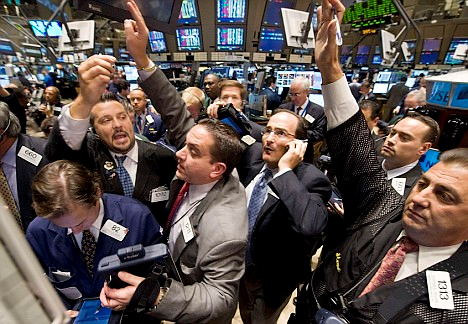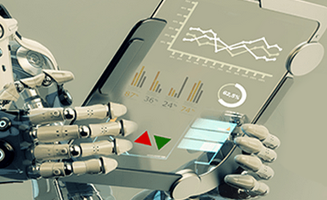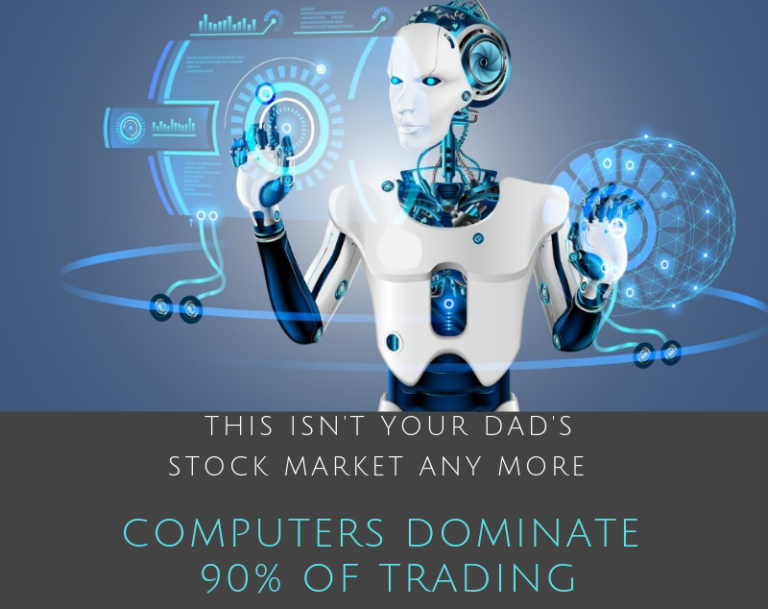Lately, we have seen unprecedented volatility in the US stock market with swings in excess of a thousand points in a couple of days for the Dow Jones Industrial Average and even the first 1,000 point gain in a single day. So, what’s causing all of this? Two things: uncertainty and computers. We’ve covered issues surrounding uncertainty in our market updates, so today we will focus on the role computers play in the volatile price swings.
“Today human beings make up 10% or less of all trading and computers make up 90%” source: JP Morgan
Although the computers are programmed by human beings, computers are responsible for nearly 90% of daily trading volume. And, while I think computers are part of the issue, the ultimate blame really lies with the people behind the computers. The computers are just following their instructions, but they are doing it at lighting fast speed without the benefit of human judgement to override programming rules when appropriate.
How did computers come to dominate trading activity? A quick history lesson …
25 years ago, trading on the stock exchange was dominated by human beings. Small orders for stock were routinely matched up with buyers and sellers in an orderly fashion while large blocks of stock were handled by something called “specialists”.

A specialist was responsible for maintaining an orderly market when large blocks of stock were transacted. The specialist would get an order from a brokerage firm that a large block of stock was for sale. He or she would then notify the floor traders (these guys) that the large block of stock was available to buy. The specialist would then offer anyone the stock at a price slightly below the most recent transacted price. The discount served to entice as many buyers as possible to get the stock sold quickly and efficiently. This way, the stock would not have to be broken up into hundreds of tiny orders all at various prices. Any leftover stock that was not purchased by the traders would be bought by the specialist with his own money. For his trouble, the specialist earned the spread on the stock, which is the increment 25 cents or less) between the price to sell and the price to buy. (source: Wall Street Journal)
This arrangement changed when Congress and government regulators decided that specialists were making too much money. They reasoned that computers could do it better, faster and cheaper, and decided to eliminate the specialist and their compensation spread. Computers were put in place with spreads of 1 or 2 cents or less.
Advocates for computerized trading say, “What’s the harm? Computers can do it better, faster and cheaper”. However, a computer can’t reason; it can only follow the instructions of the person that programmed it. Now that there are no specialists, there is no depth to the market. Meaning, if a large order to sell 1,000,000 shares is placed, but there are only enough buy orders on the other side to absorb 500,000 shares, the computer will seek orders at lower and lower prices until it completes the transaction. Sometimes, it will exhaust all the available orders at recent prices, and then seek orders at any price – even orders left in the system accidentally at 1 cent. When this scenario happens, it’s called a “flash crash” (source: Wikipedia)
For example: On May 5th, 2010…
Exelon Corporation, one of the largest, most powerful utilities in the world, worth $30 billion at the time was briefly worthless. The stock opened at $43.35, hit zero at 2:50 pm and closed that day at $41.86.
Another on that day was Boston Beer Company, maker of Sam Adams. After opening at $59.44, the stock hit $0 for a moment and later closed at $55.82.

Accenture, opened at $41.94, hit zero at 2:50 pm and later closed at $41.09.
That same day, famed auction house Sotheby’s stock opened at $34.61 and spiked to $100,000 per share for a moment and finished $33 later that day.
Source: The Wall Street Journal, Stephen Grocer May 6, 2010 5:47 pm with more details about the 2010 Flash Crash here.
Years ago, it would take days or weeks for news or rumors to affect the price of a stock; today, it’s instantaneous. Stock market swings and corrections that previously took months to settle out now seem accelerated and happen in days.
Algorithms… Evolution or Revolution
What can you do about it? These changes make research and analysis more important than ever before. Investors must adapt to the new climate. A process to determine the real value of the companies becomes invaluable in identifying buying opportunities to capitalize when the computers go haywire. Buying anything because it’s being suggested in the media is not a sound strategy. In short, you must redefine the process for investing.
Part of adapting means that you must be ready for volatility. Volatility causes discomfort and strife in the short run, but also opportunities for the long run.
Investors today more than ever seem to want to latch on to easy ideas and hot concepts, like marijuana stocks or Bitcoin in pursuit of getting rich quick. They rarely know the particulars of a company’s balance sheet or if it has solid fundamentals, increasing sales, competent management and growing cash flow. All these things require a little bit of homework, but they can save you thousands of dollars by helping you avoid bad ideas.

David.Cross@us-am.com

